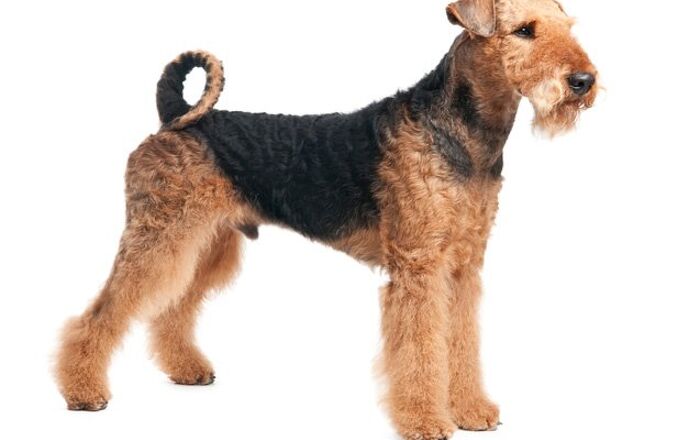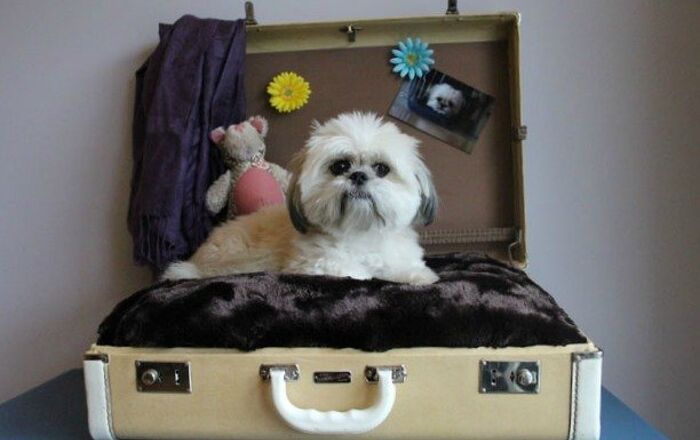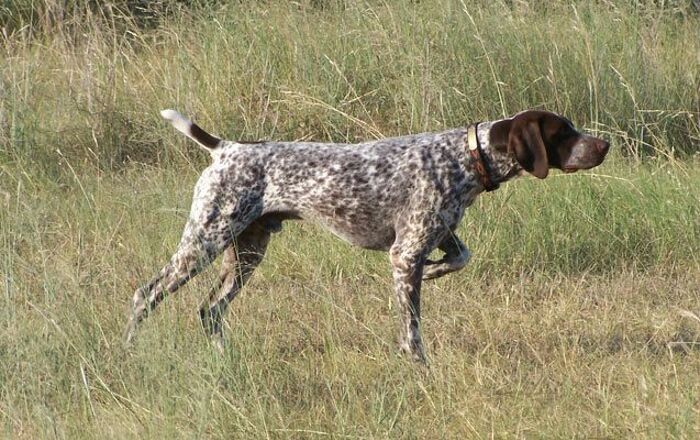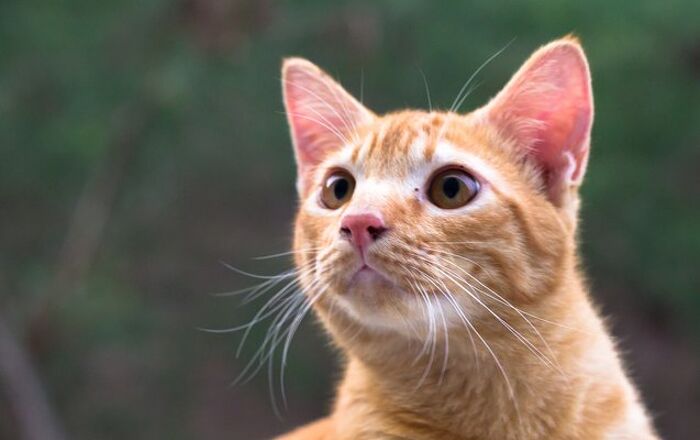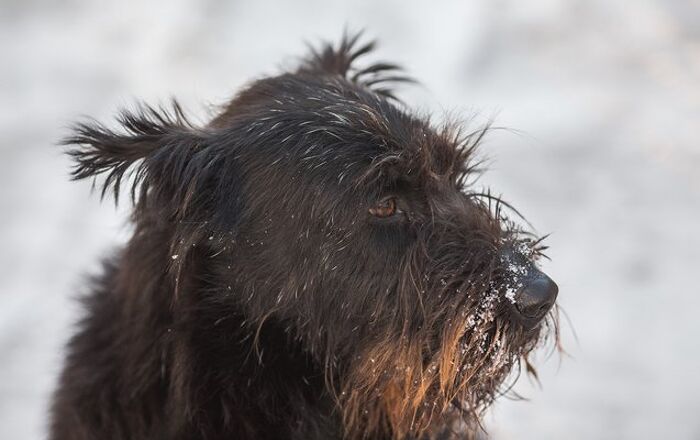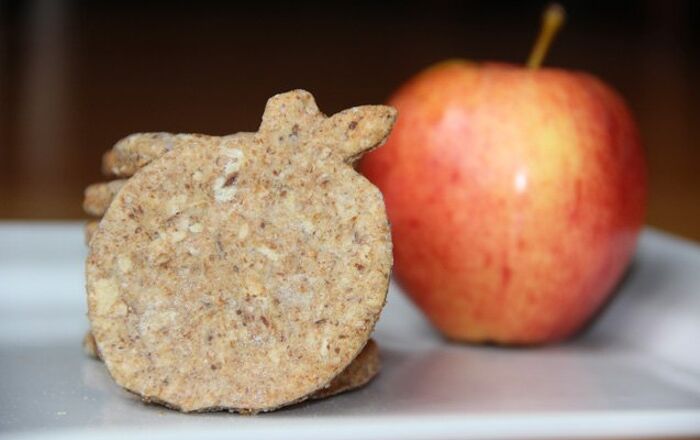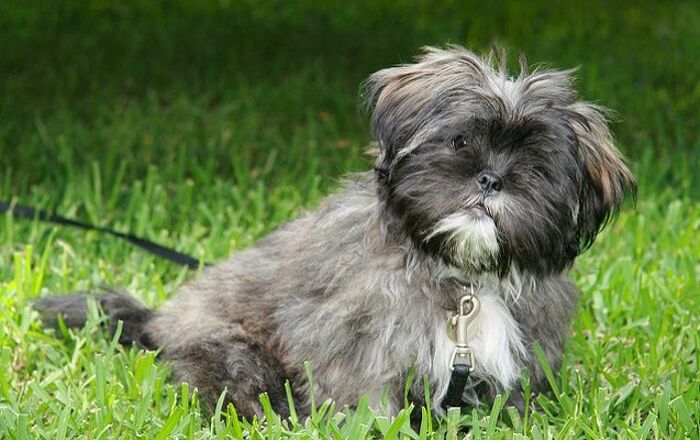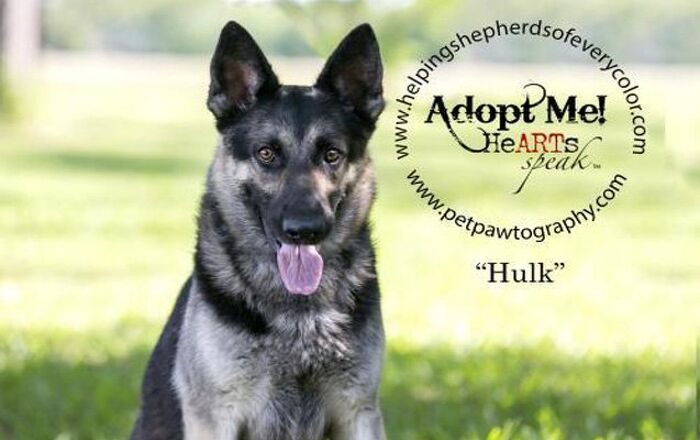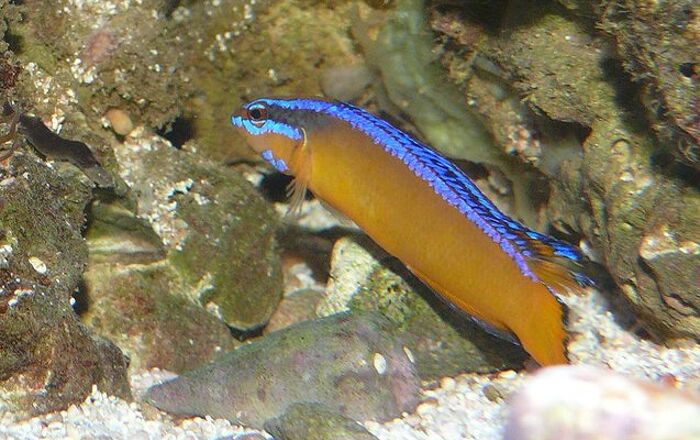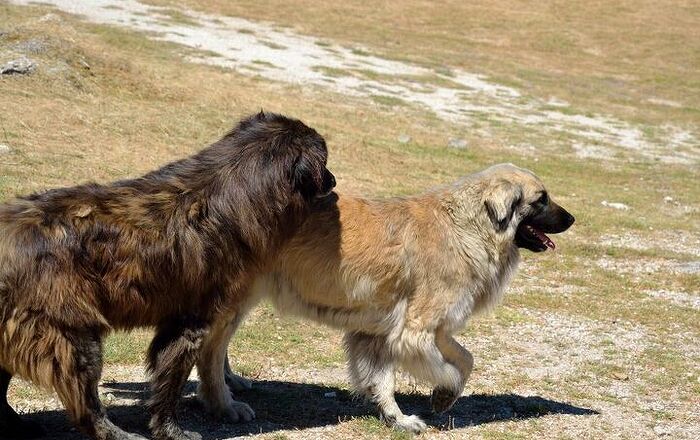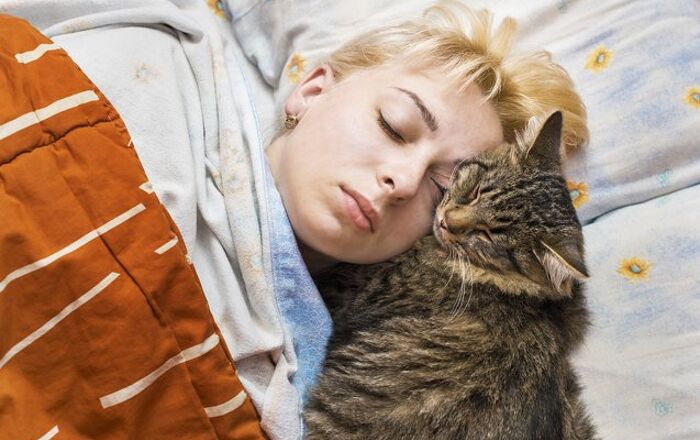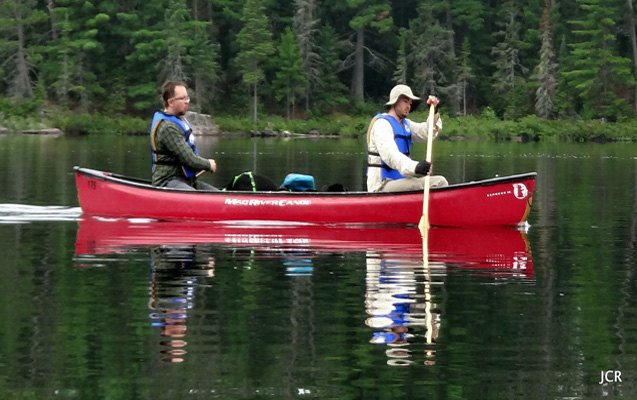
In Part 2 of his canine canoeing expedition, Kevin Roberts and his crew run into some problems finding the right campsite and take part in a stare-off contest with a moose. How’s that for an eventful first day?
Day 1: We arrive! Now what?
For the first leg of our canoe trip, we planned to paddle four hours to the first portage… that means no bathroom breaks. The dogs all know the command “Hurry Up,” which means they hurry up and go pee. With multiple dogs, this is really easy to do – when a dog pees on command, we reward with a treat, and the other ones quickly follow suit. Remember: empty bladders in the canoe means less squirmy fur butts!
Whenever possible we look for a place to allow the dogs to run off some steam before we get in the boat. A quick wresting match with their pack mates or some doggie push-ups (using the commands Down, Sit, Down, Sit, Down, Sit, etc.) can help expend some extra energy and settle down.
When we load up the canoe, we always follow the same routine. The gear goes in first, followed dog mats. In terms of passengers, my husband climbs in first, then River, followed by Belle, who usually shares a spot with River. Next Burger climbs in, and I’m the last to climb onboard, so I can push us off from shore. Most canoe tips end up happening during launch and landings, so following this calm and orderly routine keeps up dry and happy.
The first part of the paddle, down the Marten River, was hot. It was a sunny day, with no clouds in sight. All our dogs are black, so their coats attract the sun. We take frequent breaks to cool them down with water from the lake. We dip our hands in the water, and pet the dogs on their heads and chest. This brings them some relief from the heat.
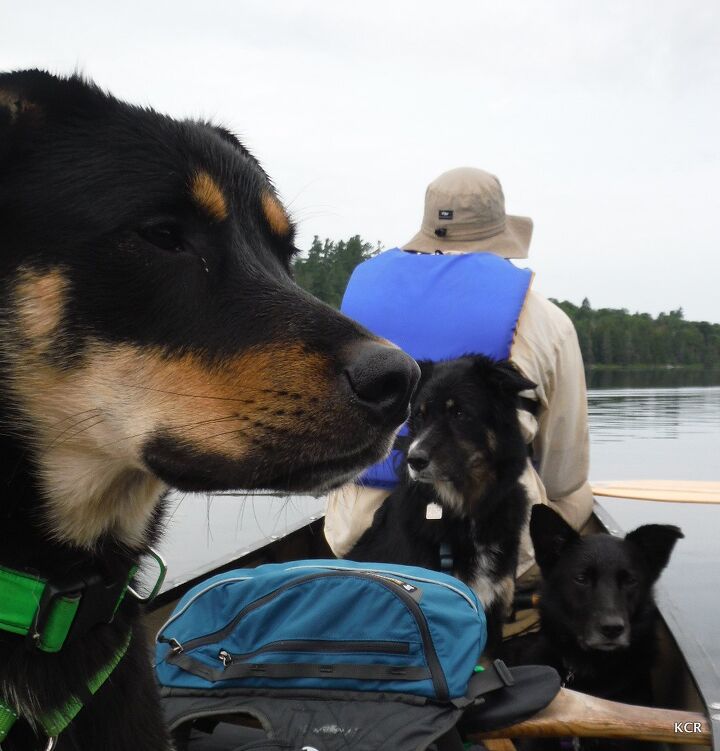
But it is not very hard for the dogs to regulate their body heat. After all, they are just laying around, and not exercising or creating any extra body heat. Our dogs have long enough hair that they don’t sunburn on the bulk of their body, but we do apply a dab on sunscreen on their noses.
After a few hours of paddling, we leave Marten River and enter Marten Lake. The area is dotted with cottages, and every cottage seems to have a dog on the end of the dock barking at us as we paddle through. I have no idea what the dock dogs are saying, but it seems to be a friendly message because our dogs take no offense as we glide by.
We decide to keep paddling to the end Marten Lake, and stop for a lunch at the portage into Wickstead Lake. The portage goes along a dirt road, and takes us on a journey past a tall dam with whitewater flowing below it. A series of crosses on the shore reminds us that this is no place to swim… for people or dogs.
Landing the canoe full of gear and dogs requires a different set of skills. All the dogs are excited to get out and stretch their legs, but they need to sit still so we can land and unload. We cruise into shore, aimed at a suitable landing spot for the canoe. The dogs start to brace themselves to jump out of the boat, but even one of them jumping before landing would be enough to unbalance the canoe.
The release word for the dogs is “Alright.” We are careful never to say this word until we are ready. Being ready means that the dogs have leashes attached to their harnesses and that we have safely landed. We don’t leash the dogs in the canoe while we are out on the water. If we were to flip, a leash could wrap around a leg or a neck, and drown one of the dogs, or one of us. Tying dogs to the canoe also means that your dog wouldn’t be able to swim to safety, should you capsize. That means leash free is the way to be on the water!
No matter how remote a site we have paddled to, the dogs are always on leash when we first land. This allows us to assess the area before the dogs can check it out. The first thing we look for are signs of other animals. Checking for bear signs or moose droppings lets us know whose home we have paddled into. We also check for old campfires, which may contain garbage or broken glass.
On the portage, we load up the dogs with their packs. The packs allow us to carry everything in one easy trip and also help slow the dogs down. It’s much easier to carry a canoe on your shoulder, and walk three dogs if they are slowed down by extra weight. The packs also allow us to maximize the dogs exercise time, and when it’s time to get back in the boat, they are a little happier!
At the end of the portage, we check the map for this new lake, and begin to scout out potential campsites. We prefer an island campsite, because a small island allows us to let the dogs have some freedom, knowing they can’t get into too much trouble. The topographical map shows a few good sites, and there are a couple of hours paddle from our current location. Time to pack up and go!
Back out on the water, the dogs settle quickly back into the canoe. After paddling for a few hours, we’ve had enough of the sun and decide to find camp. We scout out the possible tent sites from the map, but due to the high water this year, many of the sites are wet, or too close to the water.
We backtrack to a rocky outcrop I saw back closer to the portage. The site is on the mainland, which means no off leash time for the dogs, but it is open enough to offer a pleasant breeze. After scouting the site, it proves to be suitable and we decided to make camp for the night.
We still have a few hours of daylight left, so we let the dogs go for a swim. We are careful with their swimming time, ensuring that when they get wet, they still have plenty of time to dry off before bedtime. Three wet dogs in a small tent are not fun!
Dinner that night is potatoes and beans on the campfire. We never leave the fire unattended, and we don’t burn any of the leftover food or garbage. Burning food or garage is a great way to attract unwelcome visitors to your campsite! Once dinner is done, and the dishes are put away, the whole gang sits close to the fire and watches the sun set.
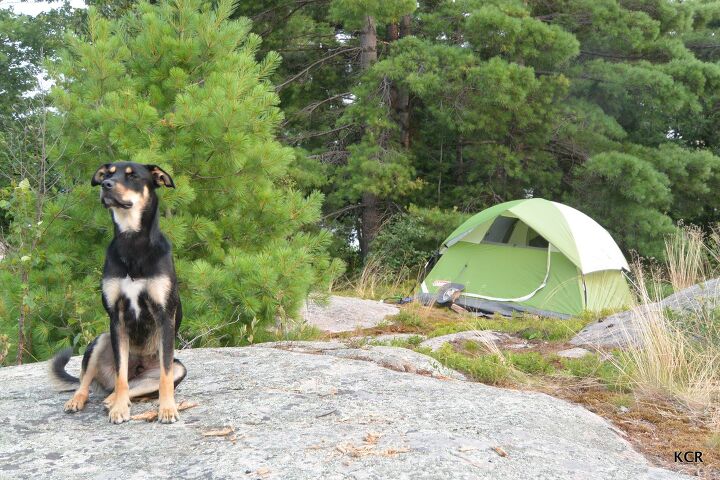
This is the time of evening when River takes her shift as campground guard, a job she takes quite seriously. She always seeks a high spot and sits very still. River has barked off countless black bears, and alerted us to grizzlies. She has also scared off camp-raiding raccoons, and once, while car camping, scared off a would-be thief who was sneaking around our site in the middle of the night!
Suddenly, River lets out a low growl, and we hear crashing in the woods across the bay. She puts her head down, and drops her pitch, staring intently. A large cow moose steps out of the woods and into the water. She stares at us for a moment, then turns and walks away.
We pack in the tent for the night. The mats that keep the dogs dry on the bottom of the canoe during the day become their camping dog beds at night. Everyone is tired and we hear the sounds of the loons calling across the water as we fall asleep.
What does the Canadian wilderness have in store for Kevin and his crew for Day 2 during their canoeing adventure? Be sure to read the next article in the series to find out.
